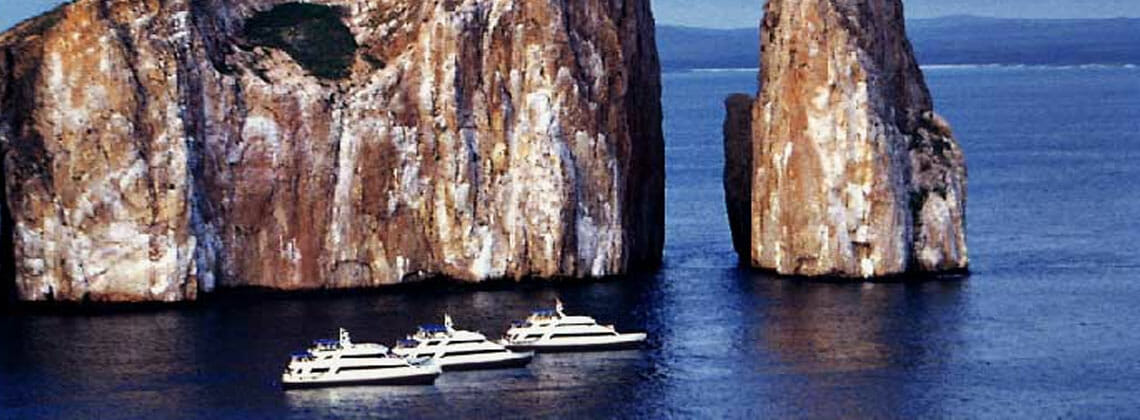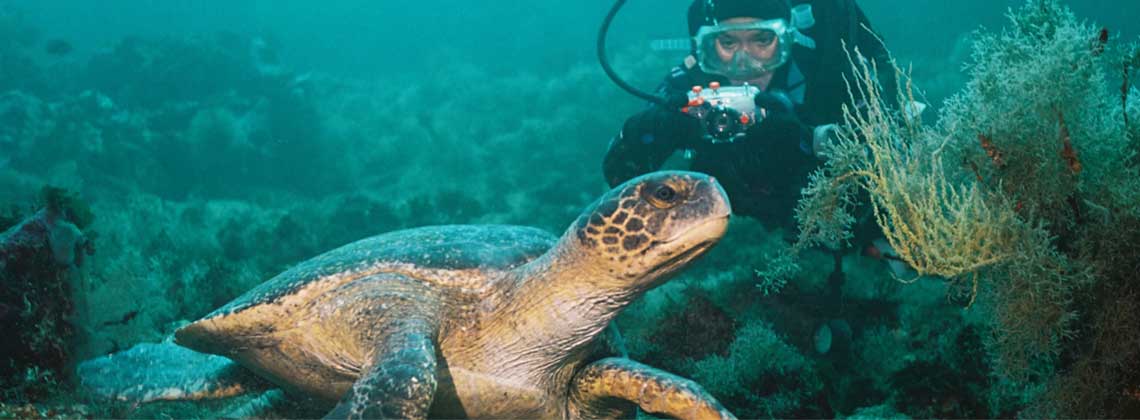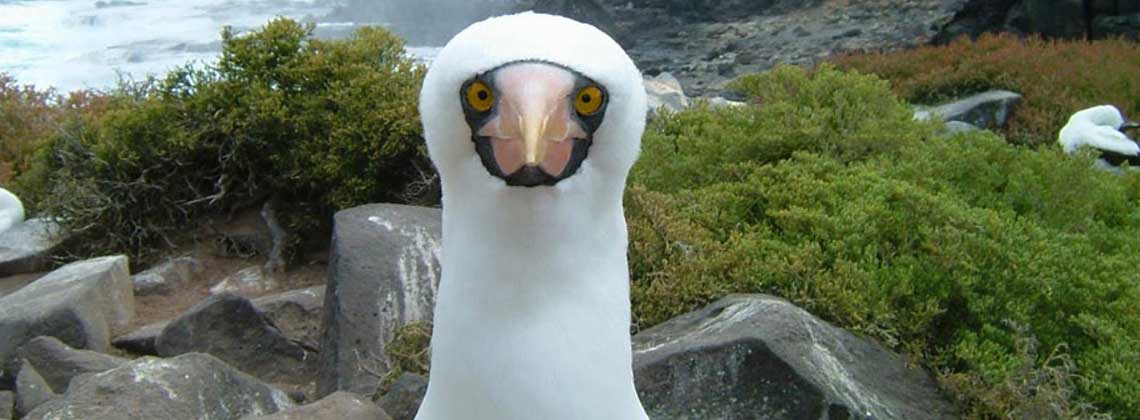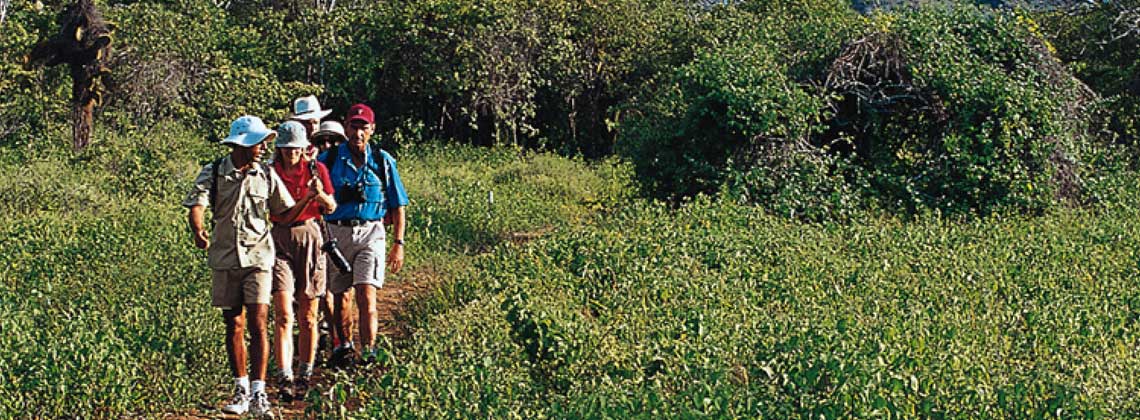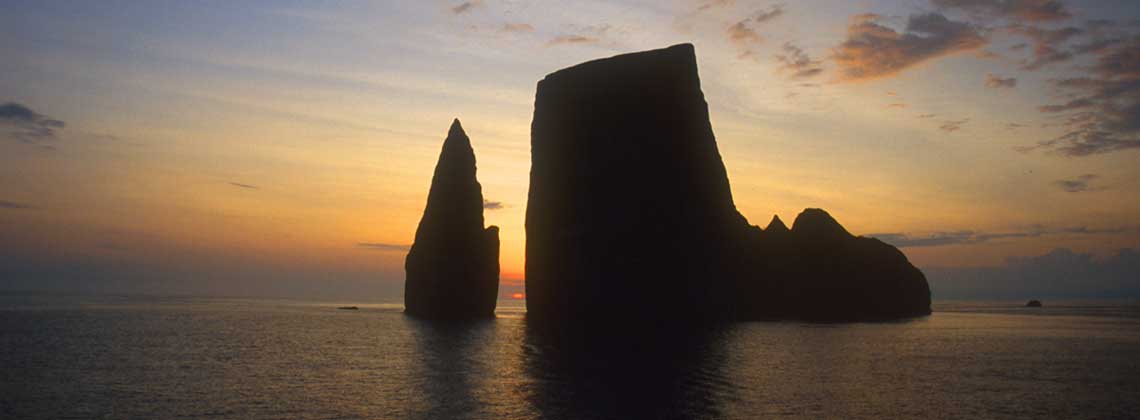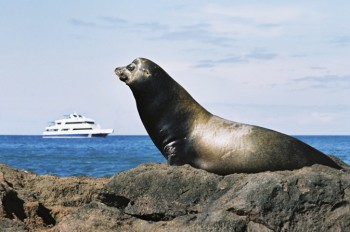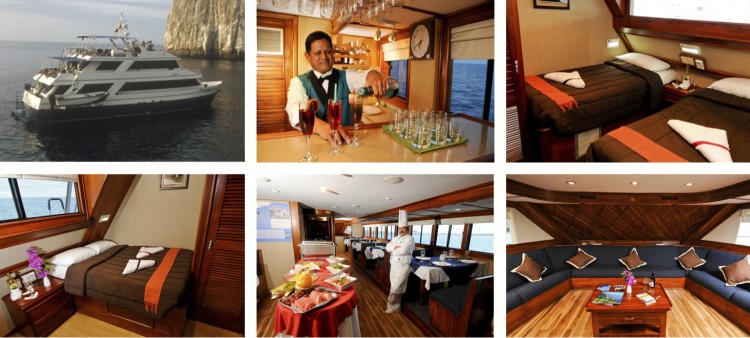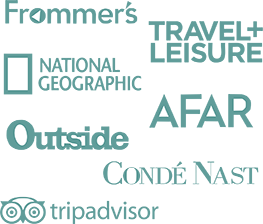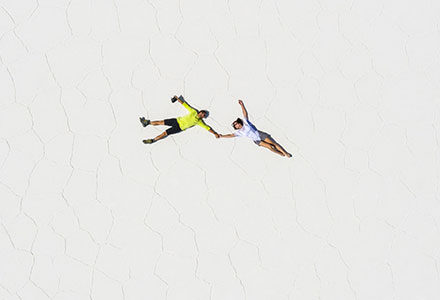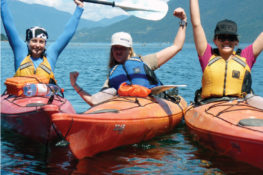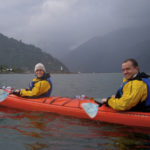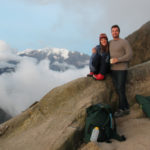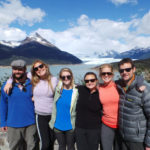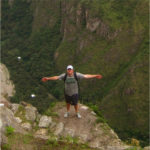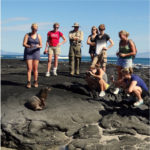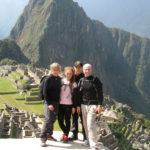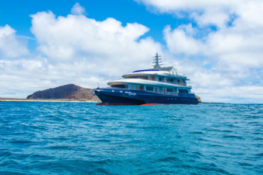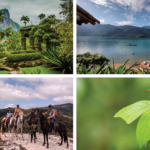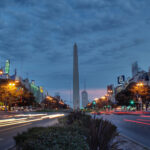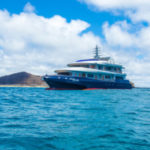Detailed Itinerary A
Day 1Sunday – Begin Cruise
Upon arrival to Puerto Baquerizo Moreno, San Cristobal Island, the crew is waiting at the airport to escort you to your anchored yacht. After the welcome briefing, a buffet lunch, and safety drill, you set sail for Playa Ochoa where you will have a wet landing. Here, you can test the snorkeling equipment and at the same time swim with a small colony of sea lions. Behind the beach, there is a tidal lagoon where birds can be spotted including the rare Chatham mockingbird. At sunset, you cruise around Kicker Rock (Leon Dormido), a vertical tuff cone formation that abruptly juts up almost 500 feet out of the ocean. On the cliffs, Blue-footed Boobies, Nazca Boobies, and Magnificent Frigate birds can be spotted.
Day 2 Monday – Cruising the Galapagos Islands
This morning, you will visit the northeast tip of San Cristobal Island. Punta Pitt, a tuff formation that serves as a nesting site for many sea birds including Blue footed, Nazca and Red-footed boobies, Frigate birds, Swallow-tailed gulls, and Storm petrels is considered to be a first class site for birds and equal to Genovesa (Tower) Island.
This afternoon you will visit Cerro Brujo (Witch Hill), a breathtaking white powder sand beach, said to be one of the most spectacular in Galapagos Islands and you will have an opportunity to snorkel or kayak right from this beach.
Day 3 Tuesday – Cruising the Galapagos Islands
This morning you will have a dry landing at Punta Suarez, Española (Hood Island), where you will witness the highest rate of endemic species in Galapagos. Sea lions noisily greet you as you land on their beach. From April to November, the waved albatross, found only on Española, perform their wild mating ritual. Colonies of blue-footed boobies engage in “sky-pointing” to show off for potential mates. Nazca boobies busily care for their young. Stunning swallow-tailed gulls are the only nocturnal gulls in the world. Red-billed tropicbirds take shelter under the cliffs. You will also find Darwin’s Finches, Galapagos Doves, and Galapagos Hawks. Here you can observe a unique species of marine iguana identified with traces of red and green colorings. Colorful sally light-foot crabs crawl along the shoreline near to the famous “blow hole”.
In the afternoon, you will have a wet landing on Gardner Bay, Española Island. Here you will walk along seemingly endless stretches of this white sandy beach where you’ll find large colonies of sea lions. There is no trail to follow so this is a chance to explore and you may find a Galapagos Hawk, Darwin’s Finches, or the Hood Mockingbird. You can swim with sea lions right from the beach, explore by kayak or just relax. There’s an excellent snorkeling site off Gardner Islet with a colorful diversity of sea life near Tortuga Rock where you can explore caves covered with invertebrates.
Day 4 Wednesday – Cruising the Galapagos Islands
This morning you step ashore at Punta Cormorant, Floreana Island, one of the few populated islands in the Galapagos. Floreana presents a rich history with mystery and intrigue. Here you will follow a trail to a brackish lagoon, home of the pintail ducks, common stilts, and the pinkest Flamingos in the world. You will also wind your way past a rich variety of plants including Morning Glory, Cut Leaf Daisies, Palo Verdes, and Scalesia leading to a beach with powder soft sand. Sea turtles lay their eggs in the sand dunes and rays swim in the shallow water. After the walk, you will have an opportunity to snorkel at Devil’s Crown, a shallow sunken crater colonized by a brilliant array of colorful fish and corral.
This afternoon you will visit Post office Bay, not the most scenic, but probably the most famous sites in Galapagos. Here is where a post barrel was put into use in the late 18th Century by English whaling vessels. You are invited to leave a post card and to pick up any mail from your home area.
Day 5 Thursday – Cruising the Galapagos Islands
This morning you visit a hidden gem on Isabela Island called Los Humedales and Muro de Lagrimas which translates to “wetlands” and “wall of teams”. This area has trails from which you find all four species of mangroves, secluded sandy beaches, with rocky shores lava tunnels and natural pools. Here you can view migratory birds including Whimrels, Short-billed Dowitchers, Wilson’s Pharlarope, Common Tern, Osprey, Semi-palmated Plovers, and mating Flamingos. The national park has released young tortoises from the breeding center in this area so you may encounter tortoises in the wild. The Wall of Tears was constructed between 1946-1959 when Isabela was still a penal colony.
In the afternoon, you will visit the Sierra Negra Volcano, located in the Southwest portion of Isabela, and considered the oldest and largest volcano on the island. From Puerto Villamil, you travel by bus to the rim of the caldera, via Santo Tomas while traversing a lava field through a series of craters and fumaroles until you reach Volcan Chico where you hike to the top. Along the way, you will usually spot the vermillion flycatcher, Galapagos Martins, Whimbrels, Egrets, and Galapagos Hawks.
Day 6 Friday – Cruising the Galapagos Islands
This morning you visit Mosquera Isalnd, a tiny islet between Baltra and North Seymour that is known for it´s long narrow beach and large population of sea lions. After a wet landing, you will have time for swimming and snorkeling on this volcanically-formed islet.
This afternoon you visit Bartolome, where it seems like you are walking on the moon. This young island is inhospitable to most plants and animals. After a dry landing, you climb 30 minutes of stairs leading to the summit of a once active volcano. Along the way, you pause to marvel at lava bombs, spatter cones, and cinder cones. From the top of the wooden stairs, you can gaze out across the island for a panoramic view of the island and of “Pinnacle Rock”, an eroded tuff cone. The crystal clear water is an invitation to snorkel from the beach and can see schools of tropical fish as well as the Galapagos Penguins
Day 7 Saturday – Cruising the Galapagos Islands
This morning, you will visit South Plaza, a small geological uplift with tall cliffs offering spectacular views. After a dry landing, the trail leads you through Prickly Pear cacti and Sesuvium. Here you can find the Galapagos Land Iguana feeding on the cactus leaves. Toward the end of the hill, you encounter a colony of bachelor sea lions. The dominant bulls are in various stages of recovery from battles lost over prime beach territory. You also find Swallow tailed gulls, Shearwaters, and Red-billed tropicbirds who build their nests along the cliffs.
In the afternoon you will travel by bus to the highlands of Santa Cruz Island. The scenery gradually changes as we wind our way through all seven vegetation zones found in Galapagos. Here, you will visit the tortoise reserve at one of the private farms in the highlands where you encounter giant tortoises in their natural habitat. You will also visit Los Gemelos, Spanish for “The Twins”, a pair of large pit craters where you find the bright red male vermilion. You stop at “the tunnels”, the largest lava tubes found in Galapagos.
Day 8 Sunday – Cruise Ends
This morning, the ship drops anchor at San Cristobal Island for the end of the cruise around the Galapagos Islands. You visit the Interpretation Center opened in 1999 where you can gain a more complete understanding of the natural and human history of the Islands. After the visit you will be escorted to Baltra airport for your return flight to the Ecuadorian mainland.
Detailed Itinerary B
Day 1 Sunday – Begin Cruise
Upon arrival to Puerto Baquerizo Moreno, San Cristobal Island, the crew is waiting at the airport to escort you to your anchored yacht. After the welcome briefing and safety drill you set sail for Playa Ochoa, where you have a chance to test your snorkeling equipment and at the same time swim with a small colony of sea lions. Behind the beach, there is a tidal lagoon where birds can be spotted including the rare Chatham mockingbird. At sunset, you cruise around Kicker Rock (Leon Dormido), a vertical tuff cone formation that juts almost 500 feet out of the ocean. On the cliffs, are blue-footed boobies, masked boobies, and frigate birds.
Day 2 Monday – Cruising the Galapagos Islands
Today you will spend the entire day on Tower Island (Genovesa), considered to be one of the most spectacular Islands in Galapagos for bird species. This morning, you will have a dry landing at Prince Philip’s Steps. Red-footed boobies nest here in Palo Santo trees and Nazca (formerly masked) boobies nest near the trail. In an open lava field, you will find storm petrels in large numbers. If you are lucky, you will see the elusive short-eared owl.
After lunch, sea kayaks are available to paddle along the shoreline. Keep a lookout for the beautiful red-billed tropic bird that is usually seen in a crevice. A snorkeling opportunity is offered along the inner rim of the volcanic crater. You land on Darwin Bay, a coral sand beach where swallow-tailed and lava gulls gather near the tide pools. Afterwards you pass through a forest of Optuntia cactus and mangroves where colonies of great frigate birds nest. The males inflate their red-throated pouches to attract females as they fly overhead. The trail leads through a rich inter tidal zone where you can find a wide diversity of animal life. You will also have the opportunity to swim at the beach with the sea lions.
Day 3 Tuesday – Cruising the Galapagos Islands
This morning, you will visit Las Bachas, which is the Spanish translation for “barges.” There is a long stretch of a soft white-sand beach and interior lagoons where we have the chance to see flamingoes. There is also a wonderful chance to snorkel here from the beach. A remnant of the U.S. presence from World War II, a floating pier, is found here.
This afternoon, you disembark on the island of North Seymour, a small geological uplift. After a dry landing, you follow a trail that leads to swallow-tailed gulls, blue-footed boobies, and the endemic land iguanas. Here you also find the largest colony of magnificent frigate birds found in Galapagos. As you stroll along the beach, you might be able to observe sea lions body surfing the northern swells.
Day 4 Wednesday – Cruising the Galapagos Islands
This morning, you will visit Tagus Cove, located on the western Island of Isabela, the largest Island in Galapagos that was formed by the lava flows of six different volcanoes. On your walk, you discover a salt-water lagoon, a scenic overlook with a spectacular view of the ocean, lava fields, and volcanic formations. Graffiti dating back to the 1800′s is written on the rocky cliffs. You can explore the Cove in pangas or sea kayaks to find Galapagos penguins, boobies, pelicans, and other seabirds.
After lunch, you cross the Bolivar Canal. Be on the lookout for whales and dolphins riding the bow wave. You disembark at Punta Espinoza on Fernadina Island, the youngest and most pristine Island found in Galapagos. Hundreds of marine iguanas, the largest colony in Galapagos, bask in the sun along the rugged shoreline. You can observe sea lion harems with resident bulls carefully guarding their territory. Flightless Cormorants build their nests on the point and Galapagos Hawks fly overhead. Recent lava flows formed by an active volcano stretch their way around the coast. Snorkeling here provides opportunities to see many sea turtles.
Day 5 Thursday – Cruising the Galapagos Islands
This morning, you will stroll along the shore at Puerto Egas on Santiago Island while looking for octopus, starfish, and other sea life caught in the tide pools. At low tide, you can catch a glimpse of marine iguanas as they feed on exposed green algae. Watch for great blue herons, lava herons, American oystercatchers, and yellow-crowned night herons. The walk ends at the grottos, deep pools of clear water where you encounter fur sea lions that were once on the verge of extinction. Before returning to the yacht, there is a snorkeling opportunity where you can observe large numbers of tropical fish.
On Bartholomew Island, it seems like you are walking on the moon. This young island is inhospitable to most plants and animals. After a dry landing, you walk 30 minutes up a set of large stairs leading to the summit of a once active volcano. Along the way, you pause to marvel at lava bombs, spatter cones, and cinder cones. From the top of the wooden stairs, you can gaze out across the island for a panoramic view of the island and “Pinnacle Rock”, an eroded tuff cone. Down below, crystal clear water is an invitation to snorkel with schools of tropical fish and Galapagos Penguins. On the other side of the Island, you have the chance to encounter sea turtles and white-tipped sharks.
Day 6 Friday – Cruising the Galapagos Islands
Friday is feeding day at the tortoise corrals at the Charles Darwin Research Station. You will visit all three tortoise corrals and the breeding center with new hatchlings and miniature tortoises not yet ready to be repatriated. Scientists from all over the globe work at the station and conduct biological research from anatomy to zoology. You will also visit the Van Straelen Hall where there are exhibits and a short video presentation.
After lunch on board, you travel by bus to the highlands of Santa Cruz Island. The scenery gradually changes as you wind your way through all seven vegetation zones found in Galapagos. From June to January, you can find giant tortoises on a private farm in the highlands. You visit Los Gemelos, Spanish for “The Twins,” a pair of large pit craters where we can find the bright red male vermilion flycatcher. There is a stop at “the tunnels,” the largest lava tubes found in Galapagos. Afterwards, you stroll through the town of Puerto Ayora (population: 15,000), the largest town in the Galapagos, where you have the opportunity to buy souvenirs, mail postcards, or spend time at an internet cafe in what is the social heart of the Islands.
Day 7 Saturday – Cruising the Galapagos Islands
This morning, step onto Gardner Bay, Española Island (Hood). You will walk along seemingly endless stretches of sandy beach where you’ll find large colonies of sea lions. There is no trail to follow, so this is a chance to explore. Here you may find a Galapagos Hawk, Darwin’s Finches or the Hood Mockingbird. You can also swim with sea lions from the beach. There is an excellent snorkeling site off Gardner Islet with a colorful diversity of sea life.
This afternoon, you disembark at Punta Suarez, Española, where you witness the highest rate of endemic species in Galapagos. From April to November, the waved albatross, found only on this island, performs its wild mating ritual. Colonies of blue-footed boobies engage in “sky-pointing” to show off for potential mates. Nazca (formerly masked) boobies busily care for their young. Stunning swallow-tailed gulls are the only nocturnal gulls in the world. Red-billed tropicbirds take shelter under the cliffs. You also find Darwin’s Finches, Galapagos Doves, and Galapagos Hawks. You can observe a unique species of marine iguana identified with traces of red and green colorings. Sally light-foot crabs crawl along the shoreline near the famous “blow hole.”
Day 8 Sunday – Cruise Ends
This morning, the ship drops anchor in Puerto Baquerizo Moreno, San Cristobal for the end of the cruise around the Galapagos Islands. You visit the Interpretation Center opened in 1999 where you can gain a more complete understanding of the natural and human history of the Islands. After the visit you will be escorted to Baltra airport for your return flight to the Ecuadorian mainland.

